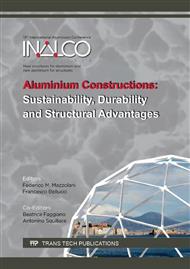[1]
Mishra, R.S. and Z.Y. Ma, Friction stir welding and processing. Materials Science and Engineering: R: Reports, 2005. 50(1–2): pp.1-78.
DOI: 10.1016/j.mser.2005.07.001
Google Scholar
[2]
Sun, Y., H. Fujii, and N. Tsuji, Microstructure and mechanical properties of spot friction stir welded ultrafine grained 1050 Al and conventional grained 6061-T6 Al alloys. Materials Science and Engineering: A, 2013. 585: pp.17-24.
DOI: 10.1016/j.msea.2013.07.030
Google Scholar
[3]
Moreira, P.M.G.P., et al., Mechanical and metallurgical characterization of friction stir welding joints of AA6061-T6 with AA6082-T6. Materials & Design, 2009. 30(1): pp.180-187.
DOI: 10.1016/j.matdes.2008.04.042
Google Scholar
[4]
Krishnan, K., On the formation of onion rings in friction stir welds. Materials science and engineering: A, 2002. 327(2): pp.246-251.
DOI: 10.1016/s0921-5093(01)01474-5
Google Scholar
[5]
Threadgill, P.L., et al., Friction stir welding of aluminium alloys. International Materials Reviews, 2009. 54(2): pp.49-93.
DOI: 10.1179/174328009x411136
Google Scholar
[6]
Hamilton, C., S. Dymek, and M. Blicharski, A model of material flow during friction stir welding. Materials Characterization, 2008. 59(9): pp.1206-1214.
DOI: 10.1016/j.matchar.2007.10.002
Google Scholar
[7]
Mahoney, M., et al., Properties of friction-stir-welded 7075 T651 aluminum. Metallurgical and materials transactions A, 1998. 29(7): p.1955-(1964).
DOI: 10.1007/s11661-998-0021-5
Google Scholar
[8]
Guduru, R.K., et al., Evaluation of mechanical properties using shear–punch testing. Materials Science and Engineering: A, 2005. 395(1–2): pp.307-314.
DOI: 10.1016/j.msea.2004.12.048
Google Scholar
[9]
Prisco, U., et al., Influence of welding parameters and post-weld aging on tensile properties and fracture location of AA2139-T351 friction-stir-welded joints. Materials Research, 2013. 16: pp.1106-1112.
DOI: 10.1590/s1516-14392013005000099
Google Scholar
[10]
Sharma, C., D.K. Dwivedi, and P. Kumar, Effect of welding parameters on microstructure and mechanical properties of friction stir welded joints of AA7039 aluminum alloy. Materials & Design, 2012. 36: pp.379-390.
DOI: 10.1016/j.matdes.2011.10.054
Google Scholar
[11]
Guo, J.F., et al., Friction stir welding of dissimilar materials between AA6061 and AA7075 Al alloys effects of process parameters. Materials & Design, 2014. 56: pp.185-192.
DOI: 10.1016/j.matdes.2013.10.082
Google Scholar


